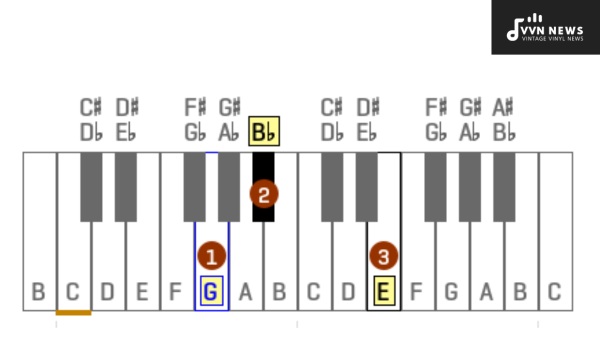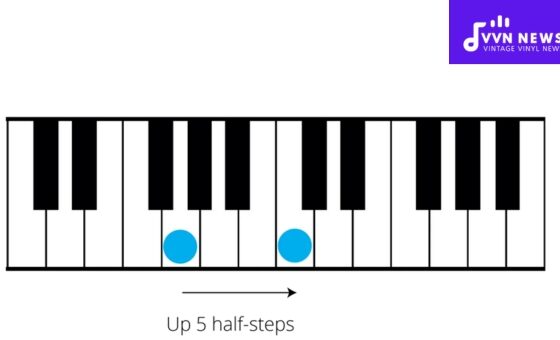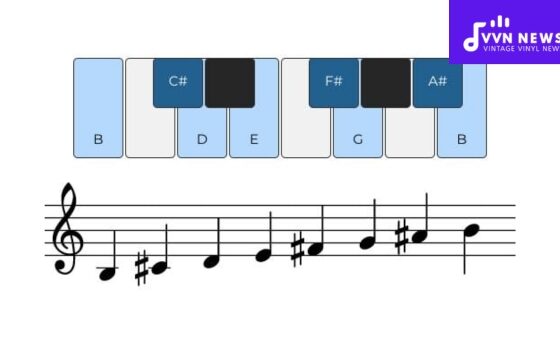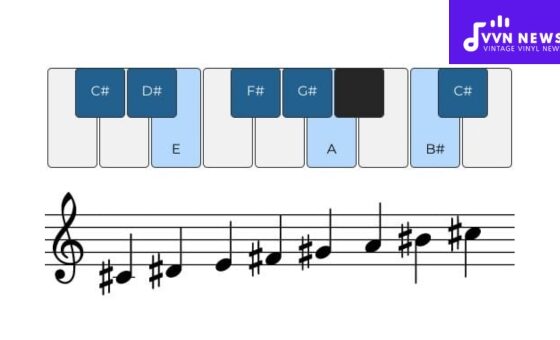Welcome to the beautiful world of music theory, where every note, every chord, and, yes, every triad has a role to play.
Among them, one that often sparks curiosity is the E diminished triad – seemingly simple on paper yet nuanced in its depth.
The mastery of these profound concepts will shape your musical journey and provide you with tools to express your creativity in ways you never thought possible.
The E diminished triad may seem complex, particularly if you’re starting out. It doesn’t have to be intimidating or abstract, however – think of it as learning a new recipe.
With the right ingredients and proper instructions in place, even a beginner can whip up something amazing.
Let’s get familiar with this intriguing musical element and see how it can add an unexpected flavor to your bustling kitchen of sounds.
What is the E Diminished Triad?
The E Diminished Triad is a three-note chord consisting of the notes E, G, and B♭. It belongs to the family of diminished triads, which are characterized by their unique, dissonant sound.
The diminished triad is built by stacking two minor thirds on top of each other.
In the case of E Diminished Triad, we start with the root note E, then add G which is a minor third above E, followed by B♭, which is another minor third above G.
This chord has a tense and unresolved quality, making it suitable for adding tension and suspense to musical compositions.
Its distinctive sound makes it a popular choice in jazz, classical, and even rock music genres.
To understand the sound of the E Diminished Triad better, imagine playing all three notes simultaneously on your instrument.
You will notice that it creates an unsettled or dark atmosphere due to its dissonance.
The formula for constructing this triad can be represented as 1-b3-b5 where 1 represents the root note (E), b3 represents G (flattened third), and b5 represents B♭ (flattened fifth).
How is the E Diminished Triad Constructed?
The E Diminished Triad is formed by stacking three notes in thirds, using the root note E as the starting point.
We begin by playing E, skip a note, and play the next one, G. Then, we skip another note and play B♭.
This sequence of intervals between each note creates the unique sound and character of the diminished triad.
In terms of intervals, the distance between E and G is a minor third (3 half steps), while the distance between G and B♭ is also a minor third.
This consistent pattern of minor thirds gives the diminished triad its distinct tonality.
Another way to understand how the E Diminished Triad is constructed is by examining its relationship to the E diminished scale.
The diminished scale consists of eight notes that alternate whole steps and half steps.
When we take every other note from this scale starting on E (E-G-B♭-D♭), we end up with the three notes that form the E Diminished Triad.
Also Read: E Flat Music Note [Master The Symbols Of Musical Notation]
Why is the E Diminished Triad Important in Music?
The E Diminished Triad holds great importance in the world of music due to its versatile nature and its ability to create tension and suspense. Here are a few reasons why this chord is significant:
- Versatility: The E Diminished Triad can be used in a variety of musical genres, from classical to jazz, rock to blues. Its unique sound adds a distinct flavor to compositions and helps create memorable musical moments.
- Tonal Ambiguity: The dissonant and tense nature of the diminished triad makes it perfect for creating tension within a piece of music. It adds an unexpected twist that catches listeners’ attention and generates interest.
- Chromatic Movement: Utilizing the E Diminished Triad allows for smooth chromatic movement in melodic or harmonic progressions. Its diminished qualities provide excellent options for transitioning between different chords, creating beautiful harmonic resolutions.
- Voice Leading: When used properly, the diminished triad can create seamless voice leading by resolving its dissonance to more stable chords or notes, creating a satisfying musical resolution.
- Compositional Depth: Incorporating the E Diminished Triad into your compositions opens up new possibilities for expressing emotions and musical ideas. It adds complexity and depth to your melodies, harmonies, and overall sound.
Whether you’re a composer, songwriter, or improviser, exploring the E Diminished Triad can greatly enhance your repertoire and allow you to craft more captivating musical experiences for your audience.
How to Play the E Diminished Triad on the Guitar
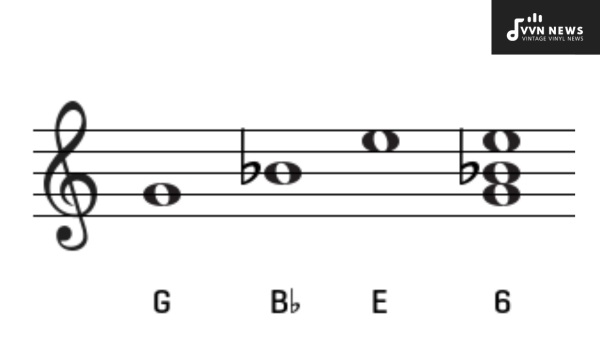
When it comes to playing the E Diminished Triad on the guitar, it is essential to understand the chord’s structure and fingerings. Follow these steps to play the E Diminished Triad on your guitar effectively:
- Start with the root note: The root note of the E Diminished Triad is E. Begin by finding this note on your guitar. You can find it on the 7th fret of the A string.
- Place your fingers: To form the triad, place your first finger on the 7th fret of the A string (E), your third finger on the 8th fret of the D string (G), and your second finger on the 7th fret of the G string (B♭).
- Strum or pick: Once you have positioned your fingers correctly, strum or pick across all three strings, starting from the A string, to play all three notes simultaneously.
- Experiment with different voicings: There are various ways to play a diminished triad on a guitar neck depending on which voicing suits you best. Explore different inversions and positions to find what feels most comfortable for you.
- Practice transitions: Transitioning smoothly between chords is important in creating seamless melodies or chord progressions. Practice moving between E Diminished Triad and other chords so you can incorporate it naturally into your playing.
Remember that consistent practice is crucial in mastering any chord or technique on guitar. Spend time familiarizing yourself with different inversions and positions of the E Diminished Triad across different areas of the neck to improve your versatility and creativity when playing music.
How to Play the E Diminished Triad on the Piano?
Playing the E Diminished Triad on the piano requires a solid understanding of both the keyboard layout and basic music theory concepts. Here is a step-by-step guide to help you successfully navigate and master this chord:
- Start by positioning your right hand on the piano keyboard. Place your thumb (T) on E, your middle finger (M) on G, and your pinky finger (P) on B♭.
- Now, let’s examine the position of your left hand. Position your thumb (T) on any low E note, either an octave below or wherever it feels comfortable for you.
- Once you have established the correct finger positions for both hands, press down all three keys simultaneously—E with your right thumb, G with your right middle finger, and B♭ with your right pinky finger.
- Pay attention to proper posture and hand positioning while playing: keep your wrists relaxed and slightly elevated above the keys, and curve your fingers downward onto the keys for optimal dexterity.
- Experiment with different inversions of the diminished triad by changing the order of notes in each hand. For example, try placing G in your left hand’s pinky finger instead of doubling it in the right hand.
Spend some time familiarizing yourself with this chord shape and its different voicings across various registers of the piano keyboard. Once you feel comfortable playing this triad notionally in one key, try transposing it to other keys to expand your musical horizons.
If you are struggling to play or find these notes at first, don’t worry—it takes time to build muscle memory and coordinate finger movements accurately. Take it slow initially and gradually increase speed as you gain confidence.
Also Read: D Sharp Minor Blues Scale [Master The Moods Of Music Theory]
How Does the E Diminished Triad Sound in Different Musical Contexts?
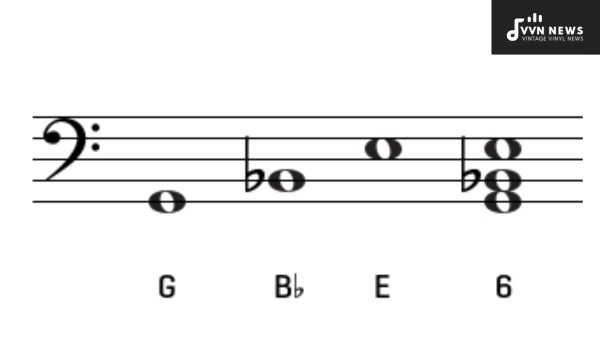
The E Diminished Triad possesses a distinct sound that can evoke various emotions and atmospheres depending on its musical context.
By understanding how this chord functions in different genres and styles, you can effectively incorporate it into your compositions. Let’s explore some of these contexts:
Jazz
In the realm of jazz, the E Diminished Triad is often used as a passing chord or for harmonic tension. Its dissonant and unresolved nature provides an element of surprise and anticipation to jazz progressions.
Jazz musicians frequently employ this triad to create tension before resolving it to a more stable chord, adding complexity and color to their improvisations.
Classical Music
In classical music, the E Diminished Triad can be found in various contexts such as modulation, chromatic harmony, or creating suspenseful passages.
Its unique sound adds depth and richness when incorporated into a classical composition. Composers may utilize this chord to build momentum, leading to resolution or contrasting with consonant chords for dramatic effect.
Film Scoring
Within the realm of film scoring, the E Diminished Triad is often employed to create suspense, tension, or a sinister atmosphere. Its dissonant quality lends itself well to accompanying thrilling or ominous scenes in movies.
The chords’ unresolved nature keeps audiences on edge while heightening their emotional impact.
Pop/Rock Music
Even in popular music genres like pop and rock, the E Diminished Triad finds its place to add flavor and color to chord progressions. It can be used as an unexpected harmonic twist within a catchy melody or as part of more intricate arrangements.
Incorporating this triad can elevate simple chord patterns into more complex and engaging musical structures.
Also Read: E Flat Major Blues Scale [Enhance Your Musical Expression]
How to Incorporate the E Diminished Triad into Songwriting
The E Diminished Triad can be a valuable tool for songwriters looking to add tension and color to their compositions. Here are some techniques and ideas that will help you incorporate this unique chord into your songwriting process.
- Establish a sense of tension: The E Diminished Triad’s dissonant nature makes it an excellent choice for creating tension in your song. Begin by using the triad as an introductory chord, leading into a more stable and resolved progression.
- Exploring modulation: Modulation is the process of changing key within a song. Utilizing the E Diminished Triad can facilitate smooth modulations by acting as a pivot chord between keys. Experiment with transitioning from one key to another using this versatile triad.
- Use in emotional sections: The diminished triad offers a sense of melancholy and sadness, making it ideal for emotional sections within your song. Consider incorporating the E Diminished Triad during introspective or introspective moments to convey deep emotions.
- Melodic embellishment: Adding melodic lines that incorporate notes from the E-diminished Triad can bring complexity and interest to your melodies—experiment with weaving these notes into your vocal or instrumental lines for added musical depth.
- Chromatic movement: The E Diminished Triad can be used in chromatic progressions, where each subsequent chord moves by half-step intervals. This creates an intense and dramatic effect in your songwriting, capturing the listener’s attention.
- Contrast with major chords: Pairing the E Diminished Triad with major chords can create a striking contrast in your harmonies. For instance, transitioning from an E major chord to the Edimished triads generates a sense of tension and release.
Incorporating the E Diminished Triad into your songwriting provides opportunities to explore new sonic landscapes and evoke different emotions in your listeners.
Experiment with these techniques, and don’t be afraid to explore and push the boundaries of your creativity.
The E Diminished Triad can be a powerful addition to your songwriting toolbox, giving your compositions an extra layer of intrigue and sophistication.
Also Read: E Major Blues Scale [Unleash Your Creative Potential]
What are the Common Uses and Progressions with the E Diminished Triad?
The E Diminished Triad can be used in a variety of musical contexts to create tension, add color, or enhance harmonic progressions. Let’s explore some common uses and progressions that incorporate this intriguing chord.
1. As a Passing Chord
The E Diminished Triad can be used as a passing chord between two diatonic chords.
For example, in the key of C Major, you can use E diminished as a passing chord between C Major and D minor. This creates a smooth transition and adds a touch of suspense before resolving to the next chord.
2. In Jazz Harmony
Jazz musicians often utilize diminished chords and their triads to create harmonic complexity. The E E-diminished triad can be employed as part of an extended chord voicing, such as an E-diminished seventh chord (E°7). This adds a distinctive jazz flavor to your compositions.
3. Diminished Chromatic Mediant
The Diminished Chromatic Mediant progression involves moving from one major or minor chord to another with its root note a minor third away.
Using the E diminished triad, you can create interesting chromatic mediant progressions by transitioning between chords like C major to A♭ major.
4. Secondary Dominant Function
The E Diminished Triad can also function as a secondary dominant chord leading to A minor or D major. By treating E diminished as the V chord in relation to these keys, you create tension that resolves nicely to the tonic.
5. Substitution for Dominant Seventh Chords
In some cases, you can replace certain dominant seventh chords with their corresponding diminished triads. For instance, instead of playing B7, you can play an E-diminished triad (E-G-B♭).
This substitution technique creates an altered harmony while maintaining the overall function and tension of the chord progression.
The E Diminished Triad can be used in various genres, including jazz, classical, pop, and more. Experiment with different progressions and musical contexts to discover unique and exciting ways to incorporate this chord into your compositions.
Also Read: D Sharp Major Blues Scale [Explore Musical Possibilities]
FAQs About the E Diminished Triad
What does a diminished triad sound like?
A diminished triad has a distinct sound and is often described as dissonant, tense, or unresolved.
How is the E Diminished Triad constructed?
The E Diminished Triad is constructed by stacking the notes E, G, and B♭, which are derived from the E diminished scale.
How can I play the E Diminished Triad on the guitar?
To play the E Diminished Triad on the guitar, you can use various fingerings across different positions on the fretboard to create different voicings of the chord.
How can I play the E Diminished Triad on the piano?
On the piano, you can play the E Diminished Triad by pressing down on the keys for E, G, and B♭ simultaneously or by spreading them out across different octaves.
How can I incorporate the E Diminished Triad into my songwriting?
You can incorporate the E Diminished Triad into your songwriting by using it as a substitution for other chords in progressions or as a passing chord to create tension and add unique flavors to your compositions.
Conclusion
Understanding the E Diminished Triad is crucial for musicians looking to expand their musical knowledge and creativity.
With its unique structure and dissonant qualities, the E Diminished Triad offers immense potential for adding color and depth to compositions.
By learning how to play this triad on the guitar or piano, exploring its sound in different musical contexts, and incorporating it into songwriting and progressions, musicians can elevate their compositions to new heights.
